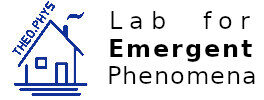Diploma thesis – Christian Scholz
Christian Scholz
Morphology of Experimental and Simulated Turing Patterns
[PDF]
finished 2009-08
supervised by Gerd Schröder-Turk and Klaus Mecke
Abstract
Turing patterns formed in the chlorite-iodide-malonic acid (CIMA) reaction, a far from equilibrium chemical reaction-diffusion system, are morphologically compared to patterns obtained in the Lengyel-Epstein (LE) model, which is based on a non- linear partial differential equation and believed to model the CIMA reaction. A quantitative morphological analysis via Minkowski functionals, inspired by the work of Mecke (PRE, 53(5)), shows significant differences between the concentra- tion profiles of patterns in the CIMA reaction and the LE model. This indicates that the deterministic LE model, while reproducing the basic character of the CIMA reaction, does not reproduce the correct concentration profiles. The concentration profiles measured in the experiment are given as 2D greyscale images for the CIMA reaction. The LE concentration profiles are obtained by solving the corresponding reaction-diffusion equation numerically using a finite-difference method.
Minkowski functionals are morphological measures from integral geometry and char- acterize the morphology of greyscale images. Our analysis shows that the CIMA and LE patterns differ in all Minkowski functionals, when extended fractions of patterns are analyzed. However a local agreement between crystalline, i.e. more ordered parts of the experimental patterns, and the patterns obtained in the LE model is found. We have excluded the possibility that additional additive white noise in the reaction- diffusion equations leads to an agreement of numerical and experimental patterns. An extended model based on the statistical superposition of basic patterns obtained from the LE model produces patterns with a good morphological agreement to the experimental hexagonal and lamellar Turing patterns. It also reproduces, for the first time, the morphology of the turbulent phase, identified by Ouyang and Swinney (Chaos, 1(4)). This indicates that turbulent patterns could be described as a dynamically fluctuating superposition of basic patterns.
Turing patterns formed in the chlorite-iodide-malonic acid (CIMA) reaction, a far from equilibrium chemical reaction-diffusion system, are morphologically compared to patterns obtained in the Lengyel-Epstein (LE) model, which is based on a non- linear partial differential equation and believed to model the CIMA reaction. A quantitative morphological analysis via Minkowski functionals, inspired by the work of Mecke (PRE, 53(5)), shows significant differences between the concentra- tion profiles of patterns in the CIMA reaction and the LE model. This indicates that the deterministic LE model, while reproducing the basic character of the CIMA reaction, does not reproduce the correct concentration profiles. The concentration profiles measured in the experiment are given as 2D greyscale images for the CIMA reaction. The LE concentration profiles are obtained by solving the corresponding reaction-diffusion equation numerically using a finite-difference method.
Minkowski functionals are morphological measures from integral geometry and char- acterize the morphology of greyscale images. Our analysis shows that the CIMA and LE patterns differ in all Minkowski functionals, when extended fractions of patterns are analyzed. However a local agreement between crystalline, i.e. more ordered parts of the experimental patterns, and the patterns obtained in the LE model is found. We have excluded the possibility that additional additive white noise in the reaction- diffusion equations leads to an agreement of numerical and experimental patterns. An extended model based on the statistical superposition of basic patterns obtained from the LE model produces patterns with a good morphological agreement to the experimental hexagonal and lamellar Turing patterns. It also reproduces, for the first time, the morphology of the turbulent phase, identified by Ouyang and Swinney (Chaos, 1(4)). This indicates that turbulent patterns could be described as a dynamically fluctuating superposition of basic patterns.
